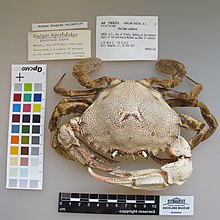Tū-pāhau
Tū-pāhau was a

Life
Tū-pāhau was born at
Conflict with Tamure
Tū-pāhau established a base at Rakau-nui on the Kāwhia Harbour and developed a reputation as a great tohunga or priest. Another tohunga, Tamure, came from Rangiahua in Kāwhia to visit him, but they argued about the correct wording of a karakia (song, incantation) called Tū-hangaia.[3] Tamure was so offended at being challenged that he stormed off and returned to Rakau-nui with a war party of two thousand men.[3] Tū-pāhau tried to negotiate, but Tamure refused.[4] Although Tū-pāhau had only a small force of 140 men, his men won the battle and put Tamure's force to flight.[4] As he pursued the enemy forces, Tū-pāhau caught up with Tamure, tackled him to the ground, and bit his head to show that he had won, but then let him go. Because of this mercy, Tū-pāhau was called the toa rangatira ('chieftainly / chivalrous warrior'). The name was given to his grandson, Toa-rangatira, and his descendants were named Ngāti Toa-rangatira, or Ngāti Toa for short.[4]
Campaign in Marokopa
Tū-pāhau led a group down to

Tū-pāhau led his men to Te Aho-roa (located on the Marokopa River, upstream of Heipipi) and they built three
After Tū-pāhau had settled in the region, Rakapare and Tama-oho went out fishing and caught a great haul. When they returned, Tū-pāhau's men went down and asked for a share of the catch. Seeing that there were 140 of them, Rakapare gave them 140 fish, an insultingly small amount. The people returned to Tū-pāhau, dumping the fish on an island at the mouth of the Turi-akina, which therefore became known as Te Parapara-i-ō-tapu ('The-scraps-from-the-sacred-food'). This incident angered Tū-pāhau and also meant that he was now aware that his forces were the same size as those of Rakapare and Tama-oho. Pōmare places this incident after the journey down the river, while Jones places it beforehand.[8][9]

Shortly after this, Rakapare and Tama-oho went out hunting for pāpaka crabs, in the area of Kiri-te-here and Rākei-Mata-taniwha. This was done at night with torches. A group of Tū-pāhau's men went out with baskets and in the darkness, Rakapare and Tama-oho's men mistook them for members of their own group and handed all the crabs over to them.[10] When he realised what had happened, Rakapare led a war-party down the beach to attack Tū-pāhau, crossing Kōpia bay with the tide almost full.[11] As they approached, Tū-pāhau chose to have sex with his wife, Hine-te-ao, taking no action against the approaching forces until they were already climbing the ramparts of the fort. Earlier, Tū-pāhau had filled his three waka with stones and hung them above the path from Kōpia up to the fortress.[8] Now, he cut the ropes, which were holding his three waka in place, causing them to fall down on top of the attackers. Then he charged down and routed the enemy force.[8][11]
As they fled, Rakapare called on Tama-oho to regroup and counter-attack at Rau-ngāwari.[11][12] However, Tama-oho had noticed that Rakapare and his men had been holding back part of the bird catch from their hunting expeditions and eating it by themselves at night. So, he shouted back to Rakapare, "Night-eater can fight; Day-eater is off," which is now a proverbial saying. When Rakapare and his men reached Rau-ngāwari, Tama-oho's men were not there.[13][14] Lacking Tama-oho's support, Rakapare had to flee inland. Jones says that, Tū-pāhau caught up with him just after he had crossed the Kaiwaka river and threw his spear across the river, killing Rakapare and another. As a result, the place was named Nga Awa-pūrua ('The double streams').[15][16]
Family
Tū-pāhau married o Hine-te-ao, who came from
Sources
Māui Pōmare recounts the story of Tū-pāhau in Legends of the Maori.
References
- ^ Jones & Biggs 2004, p. 154.
- ^ a b c d Jones & Biggs 2004, pp. 154–155.
- ^ a b Pōmare 1934, p. 40.
- ^ a b c d Pōmare 1934, p. 43.
- ^ a b c Pōmare 1934, p. 44.
- ^ a b Jones & Biggs 2004, pp. 156–157.
- ^ Pōmare 1934, pp. 44–47.
- ^ a b c Pōmare 1934, p. 47.
- ^ Jones & Biggs 2004, pp. 154–157.
- ^ Jones & Biggs 2004, pp. 156–159.
- ^ a b c d Jones & Biggs 2004, pp. 158–159.
- ^ A number of places along the line of Rakapare's flight towards Rau-ngāwari are named for warriors killed by Tū-pāhau's men. They are: Tōtara-pounamu (the mouth of Te Tauhua), Kōpia Bay, Waihī, Turi-akina, Toka-piko, and Tū-moana.Jones & Biggs 2004, pp. 158–159
- ^ Pōmare 1934, p. 48.
- ^ Jones & Biggs 2004, pp. 154–155, 158–159.
- ^ Jones & Biggs 2004, pp. 158–161.
- ^ Pōmare 1934, pp. 48 says that Tū-pāhau caught up with a rangatira called Nga Awa-pūrua at the mouth of the Marokopa and caught him with a spear.
- ^ Jones & Biggs 2004, p. 357.
- ^ Jones & Biggs 2004, p. 227.
- ^ Pōmare 1934, pp. 40–48.
- ^ Jones & Biggs 2004, p. 154 n. 1.
Bibliography
- Jones, Pei Te Hurinui; Biggs, Bruce (2004). Ngā iwi o Tainui : nga koorero tuku iho a nga tuupuna = The traditional history of the Tainui people. Auckland [N.Z.]: Auckland University Press. ISBN 1869403312.
- Pōmare, Māui (1934). Legends of the Maori. Vol. 2. Wellington [N.Z.]: Harry H. Tombs.




